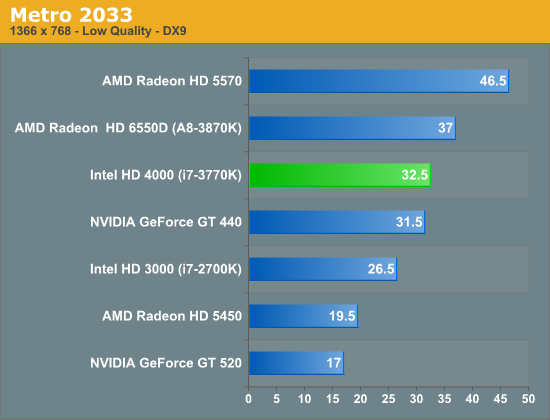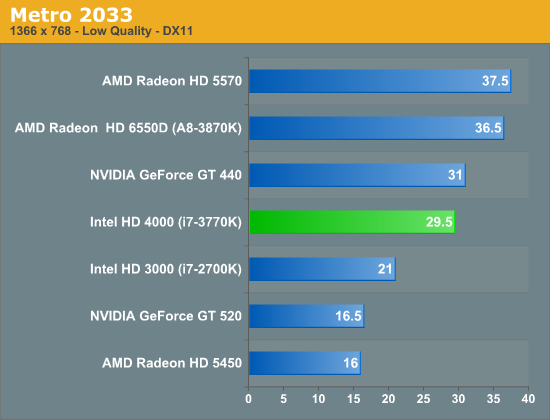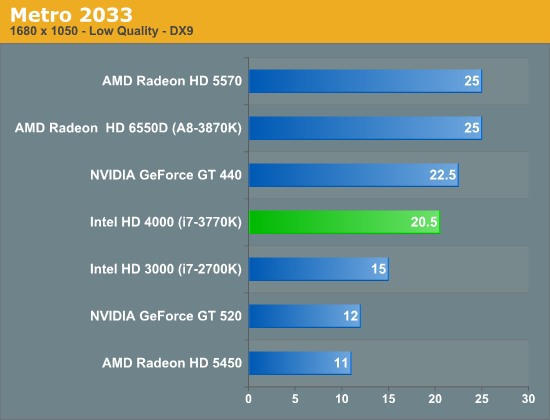The Intel Ivy Bridge (Core i7 3770K) Review
by Anand Lal Shimpi & Ryan Smith on April 23, 2012 12:03 PM EST- Posted in
- CPUs
- Intel
- Ivy Bridge
Our next graphics test is Metro 2033, another graphically challenging game. Since IVB is the first Intel GPU to feature DX11 capabilities, this is the first time an Intel GPU has been able to run Metro in DX11 mode. Like Crysis this is a game that is traditionally unplayable on Intel iGPUs, even in DX9 mode.



Here the Llano gap shrinks to about 13—25% depending on the resolution/quality settings. AMD still has the clear advantage in GPU performance, but Intel does step closer. The performance advantage over Sandy Bridge ranges from 20—40%. With these sorts of numbers it's clear why Intel views Ivy Bridge as being a tick+. Generational performance improvements on the CPU side generally fall in the 20—40% range. As you've just seen, Ivy Bridge offers a 7—15% increase in CPU performance over Sandy Bridge—making it a bonafide tick from a CPU perspective. The 20—40% increase on the graphics side is what blurs the line between a conventional tick and what we have with Ivy Bridge.










173 Comments
View All Comments
frozentundra123456 - Monday, April 23, 2012 - link
According to the Asus review just out by Anand, the Intel HD4000 and AMD HD6620 are essentially even in the mobile space, where it really matters. I dont know where you are getting the "soundly trounces" description, unless you are talking about the desktop. I dont really care about integrated graphics on the desktop, it is just too easy to add a discrete card that soundly trounces either Intel or AMD integrated. I have no doubt that AMD will regain the lead in the mobile space when Trinity comes out. I just question that they will make the kind of improvements that are being speculated about.I also find it ironic that so many people are criticizing IVB for lack of cpu improvement while in the same breath saying bulldozer is OK because it is "good enough" already.
DanNeely - Monday, April 23, 2012 - link
Primarily Einstein@Home.fastman696 - Monday, April 23, 2012 - link
Thanks for the review, but this is new Tech, why use old Tech chipset?JarredWalton - Monday, April 23, 2012 - link
You're being deliberately obtuse in order to set up a straw man.Me: "As I note in the mobile IVB article, mobile Llano GPU performance isn't nearly as impressive relative to IVB as on the desktop."
You: "The mobile variant of the part that launched last year isn't as dominant over the part that just launched today as the desktop variant is?"
In other words, you want us to compare to a product that's not out because the current product doesn't look good. I mention Trinity already, but you act as though I miss it. Then you throw out stuff like, "Thanks for resorting to namecalling" when you've already been insulting with your comments since the get go. "Sad to see this kind of crap coming from Anandtech." "I guess Anandtech's standards have drastically lowered." Put another way, you're already calling me an idiot but doing it indirectly. But let's continue....
How much faster can you do Flash video when it's already accelerated and working properly in Sandy Bridge? Web browsers are basically in the same boat, unless you can name major web sites that a lot of users visit where HD 3000/4000 is significantly worse than the competition.
Does Photoshop benefit from GPUs? Sure, and lots of people use that, including me, but the same people that use Photoshop are also the people who need more than Llano CPU performance, and more than HD 4000 or Llano or Trinity GPU performance. I'm running Bloomfield with a GTX 580, which is more than 95% of users out there. Most serious Photoshop users that I know use quad-core Intel with some form of NVIDIA graphics for a reason. But even running on straight Sandy Bridge with HD 3000, Photoshop runs faster than on Llano with HD 6620G.
Vegas, naturally, is in the same category as video transcoding. I suppose I could have said "video editing/transcoding" just to be broader. There are tons of people that don't do video editing/transcoding. Even for those that do, NVIDIA GPUs are doing far better than AMD GPUs, and NVIDIA + Intel CPU is still the platform to beat. If you want quality, though, encoding is still done in software running on the CPU; Premiere for instance really just leverages the GPU to help with the "quick preview" videos, not for final rendering (unless something has changed since the last time I played with it).
So let's try again: what exactly are the areas where Intel's Ivy Bridge and HD 4000 fall short, where AMD's Llano (or the upcoming Trinity) are going to be substantially better? All without adding a discrete GPU. Llano is equal to HD 4000 for gaming, and seriously behind on the CPU department. There are still areas where AMD's drivers are much better than Intel's drivers, and there are certain tasks (shader and geometry) where AMD is better. Really, though, the only area where Intel doesn't compete is in strictly budget laptops.
chizow - Monday, April 23, 2012 - link
Yes I have heard of a "tick", and IVB has manifested itself as a tick+ as indicated in the article which means we are basically on the 3rd generation of the same architecture introduced with Nehalem in late 2008 with some minor bumps in clockspeed/Turbo modes and overclocking headroom.Both Conroe and Nehalem were pretty huge jumps in performance only 2.5 years apart on one of Intel's Tick Tock cadence cycles and since then, nothing remotely as interesting.
Maybe you should be asking yourself why you aren't expecting bigger performance gains? Or maybe you're still reveling and ogling over Tahiti's terrible price:performance gains in the GPU space? :D
JarredWalton - Monday, April 23, 2012 - link
Yes, because that extra 10W TDP makes all the difference, doesn't it? 45W Llano parts aren't shipped in very many laptops because the OEMs aren't interested. Just look at Newegg as an example:http://www.newegg.com/Product/ProductList.aspx?Sub...
There is one current A8 APU faster than the A8-3520M for sale at Newegg, and it has an A8-3510MX. AMD's own list isn't much better (http://shop.amd.com/us/All/Search?NamedQuery=visio... there's one more notebook there with an A8-3530MX. So that's why we looked at A8-3520M, but if I had an MX chip I would certainly run the same tests -- no one has been willing to send us such a laptop, unfortunately.
But even if we got an MX chip, their GPUs are still clocked the same as the A8-3500M/A8-3520M. We might be CPU limited in a couple games, but while there are Llano parts with 20% higher CPU clocks, that just means Intel is "only" ahead by 60-70% instead of 100% faster on CPU performance.
Joepublic2 - Monday, April 23, 2012 - link
Because stock temperatures are irrelevant (much like your posting) to the end user as long as the chip isn't throttling.samal90 - Monday, April 23, 2012 - link
you people over-analyzed my comment. All I wanted to say is that they are bragging about HD 4000 when it doesn't come close to the current competition.Couple of years down the road, people won't want dedicated graphics cards in their laptops anymore..its too bulky and consumes too much power. We will all have integrated GPUs. the AMD APU is the way to go. To be honest, CPU power is already way more than enough for a lot of things most people use their laptops for (browsing the web, writing documents, play web-based games a.k.a. angry birds on chrome). The extra GPU is for people that either want to do some graphics processing or play some more graphics intensive games. So yes, it is important for the future to have a good and strong integrated GPU and a good CPU. Therefore, I think AMD will win this round. I hope they continue to compete at each other's throats so we see better and cheaper products from both sides.
So as I understand it right now: Go for AMD if you want better GPU, go for Intel if CPU is more important for you. Trinity might narrow the CPU gap however and greatly increase the GPU one. Only time will tell.
chaos215bar2 - Tuesday, April 24, 2012 - link
"Ivy Bridge is hotter, so if you're paying for the AC, it should be a negative impact."Where do you think the dissipated power is going? TDP and overall thermal output are roughly equivalent.
IVB may get hotter, but without measuring TDP overclocked and under load, that could easily be because the die is smaller and doesn't dissipate heat quite as well.
DanNeely - Tuesday, April 24, 2012 - link
"I don't understand this. We're talking about power consumption, not TDP. Heat-wise, Ivy Bridge is hotter, so if you're paying for the AC, it should be a negative impact."Power consumption is TDP. 100W of power is 100joules/second of heat to be disipated; it doesn't matter if the heat's coming off a large warm die, or a small hot one. 100W is 100W.
My current i7-9xx boxes are 130W chips; so just looking at TDP somewhere between 60 and 90W less power at stock (~50 just from the CPU TDP, the higher number the chipset's a theoretical 18 more, probably a lot less in practice, and then whatever cut of the IB's TDP is for the GPU). Probably a wider gap when OCed, but I don't have any stock vs OC power numbers to look at. With AC costs added, cost savings would probably be between $100 and $200/year per box.
Up front costs would be ~$400-550 for CPU + mobo pairs depending on how high up the feature chain I went; probably fairly high for my main box and more bang for the buck on the 2nd.
Looking on ebay for successful auctions it looks like I could get ~$250 for my existing cpu/mobo pairs less whatever ebay's fee is. The very rough guess would be a 2 yearish payback time which is somewhat better that I thought (closer to 3 years).
Not sure I'll do it since I have a few other PC related purchases on the wishlist too: replacing my creaky Core One Duo laptop with a light/medium gaming model or swapping out my netbook for a new ultra portable after Win8 launches might give better returns for my dollar. The latter's battery isn't really lasting as long as I'd like any more. Also, my WHSv1 box is scheduled for retirement this winter.
I am going to have to give it some serious thought though. Part of me still wants to wait for Haswell even though preliminary indications are that it won't be a huge step up; the much bigger GPU and remaining at dual channel memory makes a mainstream hex core part unlikely.